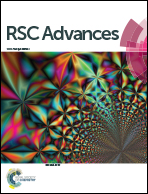A controlled Ag–Au bimetallic nanoshelled microsphere array and its improved surface-enhanced Raman scattering effect†
Abstract
We report the synthesis of polystyrene core, and Ag and Au bimetallic shell (PS@AgnAu50−n) composite microsphere arrays with different shell-thickness combinations by a two-step ion-sputtering deposition method based on monolayer colloidal crystal, and studied their surface-enhanced Raman scattering (SERS) properties experimentally and theoretically. The SERS properties of PS@AgnAu50−n composite microsphere arrays were compared with those of single silver or gold shell array structure, and the influence of the thickness of the gold outer shell was studied. The results demonstrated that partially replacing the outer silver shell with a gold layer can improve the SERS activity in addition to good stability. This work can give an optimized method for some complex Ag structures as highly active SERS-substrates, and provide a good solution to the interference caused by substrate impurity. As a demonstration, an experiment on hierarchically rough Ag-substrate has performed.


 Please wait while we load your content...
Please wait while we load your content...